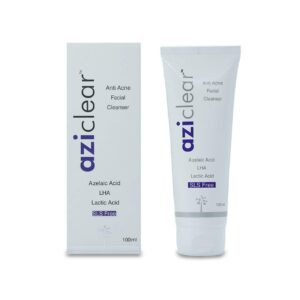AZELAIC ACID + LACTIC ACID
Azelaic Acid: Azelaic Acid is a medication that is used topically to treat skin conditions such as acne, rosacea, and melasma. It is available in the form of a cream, gel, or foam.
The exact mechanism of action of Azelaic Acid is not fully understood. However, it is believed to work by reducing the production of keratin, which helps to prevent the formation of acne lesions. It also has anti-inflammatory and antimicrobial properties, which can help to reduce redness and inflammation associated with skin conditions.
The appropriate dose of Azelaic Acid can vary depending on the formulation and the condition being treated. Generally, it is applied twice daily to the affected area, following the instructions provided by your doctor or the product label. It is important to cleanse and dry the skin before applying the medication.
Common side effects of Azelaic Acid include mild skin irritation, itching, burning, and stinging at the application site. These side effects are usually temporary and resolve on their own. In rare cases, allergic reactions such as rash, hives, or swelling may occur. If any severe or persistent side effects occur, it is important to contact a healthcare professional.
It is advisable to avoid using Azelaic Acid on broken or damaged skin, as it may cause further irritation. Additionally, it is recommended to avoid contact with the eyes, mouth, or other mucous membranes. If accidental contact occurs, rinse thoroughly with water.
Overall, Azelaic Acid is considered a safe and effective treatment option for certain skin conditions. However, it is important to consult with a healthcare professional before starting this medication to determine if it is suitable for your individual needs and to discuss any potential interactions with other medications you may be taking.
Lactic Acid: Drug: Lactic Acid
Use: Lactic Acid is a medication primarily used as a topical skin care product. It is commonly used as a chemical peel to improve the appearance of acne scars, hyperpigmentation, and rough skin texture. It is also used in some over-the-counter skin care products as a moisturizer and exfoliant.
Mechanism of Action: Lactic Acid belongs to a group of chemicals known as alpha hydroxy acids (AHAs). It exfoliates the skin by dissolving dead skin cells on the surface, promoting the growth of new, healthy skin cells. It helps to remove the outermost layer of dead skin cells, revealing a smoother and more youthful complexion.
Dose: The dose of Lactic Acid varies depending on the intended use and the specific product being used. For chemical peels, concentrations of Lactic Acid can range from 10% to 70%. It is typically applied to the skin and left on for a specified amount of time before being neutralized or rinsed off. It is important to follow the instructions provided by the manufacturer or healthcare provider for the specific product being used.
Side Effects: Lactic Acid is generally considered safe when used as directed. However, some individuals may experience mild side effects, including redness, irritation, dryness, itching, or a stinging sensation. These side effects are usually temporary and improve with continued use. In rare cases, individuals with sensitive skin may experience more severe irritation or allergic reactions. It is recommended to do a patch test before using a product containing Lactic Acid to check for any adverse reactions. If any severe or persistent side effects occur, it is important to discontinue use and consult a healthcare professional.

